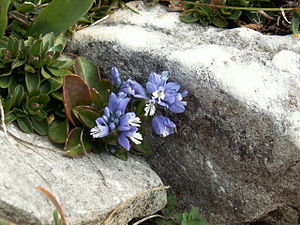Lime finial
| Lime finial | ||||||||||||
|---|---|---|---|---|---|---|---|---|---|---|---|---|

Lime finial ( Polygala calcarea ) |
||||||||||||
| Systematics | ||||||||||||
|
||||||||||||
| Scientific name | ||||||||||||
| Polygala calcarea | ||||||||||||
| FW Schulz |
The lime finial ( Polygala calcarea ), also lime-milkwort called, is a plant from the genus finials ( Polygala ) within the family of polygalaceae (Polygalaceae).
description
The lime finial grows as a perennial herbaceous plant and reaches heights of 5 to 20 centimeters. The stems are branched at the base, lying down like runners, their ends are ascending, and they end with a rosette of leaves . The leaves are relatively large with a length of 15 millimeters and a width of 7 millimeters. Several upright, flower-bearing and vegetative shoot axes with smaller leaves arise from the leaf axils .
Flowering time is from April to June. The racemose inflorescence contains 6 to 20 flowers. The bracts are longer than the pedicel. The hermaphrodite flowers are zygomorphic . Petals are mostly dark blue. The wings are 5 to 7 millimeters long and clearly network-veined, with strongly branched veins.
The number of chromosomes is 2n = 34.
Occurrence
The limestone finial is a subatlantic-west Mediterranean floral element . Their relatively small area extends in the west from southern and eastern England as the northern border via France , southern Belgium , and Luxembourg to the east to southwest Germany ; in the south it extends from northern Spain to southeastern France. Another occurrence is in north-western Switzerland on the western edge of the Jura . In Central Europe you can find very rare occurrences in the Eifel, the Saar area , in the southern Palatinate , at the Kaiserstuhl and at the southern foot of the Alps .
The lime finial thrives best on lime-rich , stony- marly , but humus-rich loam or clay soil or loess . It occurs in locations with a fairly humid and mild winter climate . It colonizes semi- arid grasslands and gaps, sparse dry bushes. She is a mesobromione bandage character.
use
The species is rarely cultivated as an ornamental plant. The best known is the 'Lillet' variety.
literature
- Otto Schmeil , Jost Fitschen (greeting), Siegmund Seybold : The flora of Germany and the neighboring countries. A book for identifying all wild and frequently cultivated vascular plants. 95th completely revised u. exp. Edition. Quelle & Meyer, Wiebelsheim 2011, ISBN 978-3-494-01498-2 .
- Eckehart J. Jäger (ed.): Excursion flora from Germany. Vascular plants: baseline. Founded by Werner Rothmaler . 20th, revised and expanded edition. Spektrum Akademischer Verlag, Heidelberg 2011, ISBN 978-3-8274-1606-3 .
- Henning Haeupler , Thomas Muer: picture atlas of the fern and flowering plants of Germany (= the fern and flowering plants of Germany. Volume 2). 2nd, corrected and enlarged edition. Published by the Federal Agency for Nature Conservation. Ulmer, Stuttgart 2007, ISBN 978-3-8001-4990-2 .
- Oskar Sebald, Siegmund Seybold, Georg Philippi (Hrsg.): The fern and flowering plants of Baden-Württemberg. Volume 4: Special part (Spermatophyta, subclass Rosidae): Haloragaceae to Apiaceae. Eugen Ulmer, Stuttgart 1992, ISBN 3-8001-3315-6 .
- Dietmar Aichele, Heinz-Werner Schwegler: The flowering plants of Central Europe. 2nd Edition. Volume 3. Franckh-Kosmos, Stuttgart 2000, ISBN 3-440-08048-X .
Individual evidence
- ↑ a b Erich Oberdorfer : Plant-sociological excursion flora for Germany and neighboring areas . 8th edition. Verlag Eugen Ulmer, Stuttgart 2001, ISBN 3-8001-3131-5 . Pages 642–643.
- ↑ Walter Erhardt among others: The great pikeperch. Encyclopedia of Plant Names . Volume 2, page 1644. Verlag Eugen Ulmer, Stuttgart 2008. ISBN 978-3-8001-5406-7
Web links
- Lime finial. In: FloraWeb.de.
- Lime finial . In: BiolFlor, the database of biological-ecological characteristics of the flora of Germany.
- Profile and distribution map for Bavaria . In: Botanical Information Hub of Bavaria .
- Polygala calcarea FW Schultz In: Info Flora , the national data and information center for Swiss flora . Retrieved December 4, 2015.
- Thomas Meyer: Data sheet with identification key and photos at Flora-de: Flora von Deutschland (old name of the website: Flowers in Swabia )
- Photos: [1] , [2] , [3]
